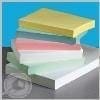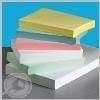Inplant Handlers
Price :
- In stock – will ship in 3 days or less
- Shields ESD sensitive items from charges and electrostatic discharges (with lid in place)
- Protektive Pak® shipping, handling, and storage containers
- Many sizes available for optimal fit of your product.
- Constructed of impregnated corrugated material for greater durability
- Static dissipative surface resistance of 1 x 106 to < 1 x 109 ohms per ANSI/ESD STM11.11
- Buried shielding layer minimizes the potential of sloughing and abrasion contamination
- Easy assembly without the need for tape, glue, or staples
- Made from 100% recycled material and is 100% recyclable
- Lid Included to shield ESD sensitive contents
- Made in the United States of AmericaTransportation of sensitive products outside of an EPA shall require packaging that provides:
1. Low charge generation.
2. Dissipative or conductive materials for intimate contact.
3. A structure that provides electrostatic discharge shielding.
(ANSI/ESD S541 section 6.2 Outside an EPA)
- In stock – will ship in 3 days or less
- Shields ESD sensitive items from charges and electrostatic discharges (with lid in place)
- Protektive Pak® shipping, handling, and storage containers
- Many sizes available for optimal fit of your product.
- Constructed of impregnated corrugated material for greater durability
- Static dissipative surface resistance of 1 x 106 to < 1 x 109 ohms per ANSI/ESD STM11.11
- Buried shielding layer minimizes the potential of sloughing and abrasion contamination
- Easy assembly without the need for tape, glue, or staples
- Made from 100% recycled material and is 100% recyclable
- Lid Included to shield ESD sensitive contents
- Made in the United States of AmericaTransportation of sensitive products outside of an EPA shall require packaging that provides:
1. Low charge generation.
2. Dissipative or conductive materials for intimate contact.
3. A structure that provides electrostatic discharge shielding.
(ANSI/ESD S541 section 6.2 Outside an EPA)”Packaging materials that are in intimate contact with devices should be dissipative.” ANSI/ESD S541 section 7.2.2 Resistance of Dissipative MaterialsESD Handbook TR 20.20 paragraph 5.4.3.3.1 Returnable and Reusable Packaging, “In some situations, packaging may be designed for reuse [and] may be reused numerous times. Examples of these types of ESD protective packaging are hinged containers, boxes, and other rigid or semi -rigid containers. The initial cost of these packages may be relatively expensive. However, if the appropriate collection and recycling system is used, the container may be the least expensive choice over time.”ESD protective packaging shall be marked with the ESD Protective Symbol.” “Packaging should be marked with information that allows traceability to the packaging manufacturer and to the manufacturer’s date/lot code information. The date/lot code should allow traceability to quality control information pertaining to the manufacture of the specific lot of packaging.” (ANSI/ESD S541 section 8.2.1 Material Identification and section 8.2.3 Traceability)
| Weight | 2 lbs |
|---|
Related products
-
Cleanroom Paper, Cleanroom Consumables, Cleanroom Paper

Cleanroom Paper, 11″ x 17″ White
$32.36 Add to cart
Cleanroom Paper, 11″ x 17″ White
$32.36
SKU: Cleanroom Paper, 11" x 17" White Categories: Cleanroom Paper, Cleanroom Consumables, Cleanroom Paper Tags: 11" x 17" White, Cleanroom PaperCleanroom Paper, 11″ x 17″, 250 Sheets/Ream, 5 Reams/Case, White
-
Cleanroom Paper, Cleanroom Consumables, Cleanroom Paper

Cleanroom Paper, 8.5″ x 11″ White
$18.40 Add to cart
Cleanroom Paper, 8.5″ x 11″ White
$18.40
SKU: Cleanroom Paper, 8.5" x 11" White Categories: Cleanroom Paper, Cleanroom Consumables, Cleanroom Paper Tags: 8.5" x 11" White, Cleanroom PaperCleanroom Paper, 8.5″ x 11″, 250 Sheets/Ream, 10 Reams/Case, White
-
Cleanroom Paper, Cleanroom Consumables, Cleanroom Paper

Cleanroom Paper, 8.5″ x 11″ Green
$18.40 Add to cart
Cleanroom Paper, 8.5″ x 11″ Green
$18.40
SKU: Cleanroom Paper, 8.5" x 11" Green Categories: Cleanroom Paper, Cleanroom Consumables, Cleanroom Paper Tags: 8.5" x 11" Green, Cleanroom PaperCleanroom Paper, 8.5″ x 11″, 250 Sheets/Ream, 10 Reams/Case, Green
-
Nomex ESD Hot Gloves, Static Control, Cleanroom Consumables, Cleanroom Gloves

FG2601 Small 11″ ESD Hot Gloves (Nomex)
$220.00 Add to cart
FG2601 Small 11″ ESD Hot Gloves (Nomex)
$220.00
SKU: FG2601 Small 11" ESD Hot Gloves (Nomex) Categories: Nomex ESD Hot Gloves, Static Control, Cleanroom Consumables, Cleanroom GlovesFG2601, 11″ Length, Size Small – ESD Hot Gloves, Cleanroom Compatible These gloves use monofilament Nomex® woven fabric suffused with carbon fiber and enhance the heat protection with a 100% inner insulating tricot knit polyester fabric liner Pricing is per Pair.
Do you have a Question or Concern?
"*" indicates required fields

